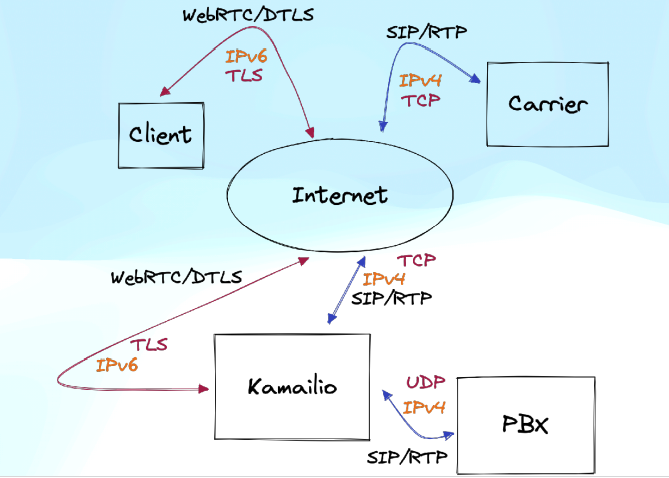On August 24, 2022, Arin welcomed Fred Posner to WebRTC Live, noting it was long overdue to have a speaker on SIP and telephony. Fred has been involved in VoIP for more than twenty years and has been working with Kamailio for more than 15. During the episode, Fred explored using Kamailio to connect WebRTC to SIP and, “if you need it,” PSTN.
What is Kamailio?
Kamailio is the successor to OpenSER and SER. It can be used to build large platforms for VoIP and real-time communications – presence, WebRTC, instant messaging and other applications; allowing you to easily bridge WebRTC endpoints to the PSTN, enterprise, and more.
- Open source SIP server
- 20 years and running
- Module based (150+ modules)
- Very fast (5,0000+ calls/sec as load balancer in stateless mode)
- Very light (300,000+ endpoints with just 4GB RAM)
Best usage scenario
Kamailio’s best usage is as a SIP edge router handling bridge and security.
- Load balancing from WebRTC end points to the server application
- Security firewalls can test anything that might protect your end application from aggressive users
- Least Cost Routing (LCR) module implements capability to serially forward a request to one or more gateways
- VoLTE (voice over LTE) setup with Kamailio IMS
Proxy vs PBX
SIP Proxy is different from PBX servers like Asterisk or FreeSwitch.
- Helps facilitate calls
- Doesn’t answer calls
- Doesn’t initiate calls
- No audio/video processing keeps it light
Kamailio as a WebRTC Bridge
The most common way Fred is seeing WebRTC used with Kamailio is as a bridge to PBX or PSTN. It is easy to deploy for call centers and similar use cases. The WebSocket module handles the framing from WebRTC to SIP.
Q&A
Questions for Fred included:
- Is the WebRTC bridge only for legacy systems? Does Kamailio have a specific module to bridge WebRTC with SIP?
- You mentioned that Kamailio does NAT very well. Does it have its own STUN/TURN servers?
- How do you implement high availability for WebRTC?
- What are your thoughts on how SIP has impacted WebRTC design and the pros and cons of SIP vs. VOIP?
- What is the role of video in Kamailio? When and how is it used?
- What are some of the gotchas for someone looking at implementing click to call?
Watch Episode #70!
The slides for the presentation can be found here. For more information on Kamailio, visit www.kamailio.org, github.com/kamailio, and #kamspace.matrix.kamailio.dev. The annual KamailioWorld conference will be online this year September 7-8, 2022.
UP NEXT! WebRTC Live #71 with Chad Hart
Wednesday, September 28 at 12:30pm Eastern.
Register today!
Do you have a topic that you would like to see discussed on WebRTC Live? Let us know by emailing news@webrtc.ventures.
Never miss an episode of WebRTC Live, our webinar series hosted by WebRTC.ventures Founder and CEO, Arin Sime. We feature the latest use cases and technical updates to this increasingly popular coding standard for live video. Watch past episodes on our WebRTC Live page, our YouTube channel, and on our blog. Better yet, use the form in the sidebar to join our mailing list and be among the first to hear about upcoming episodes and the latest news in WebRTC!













